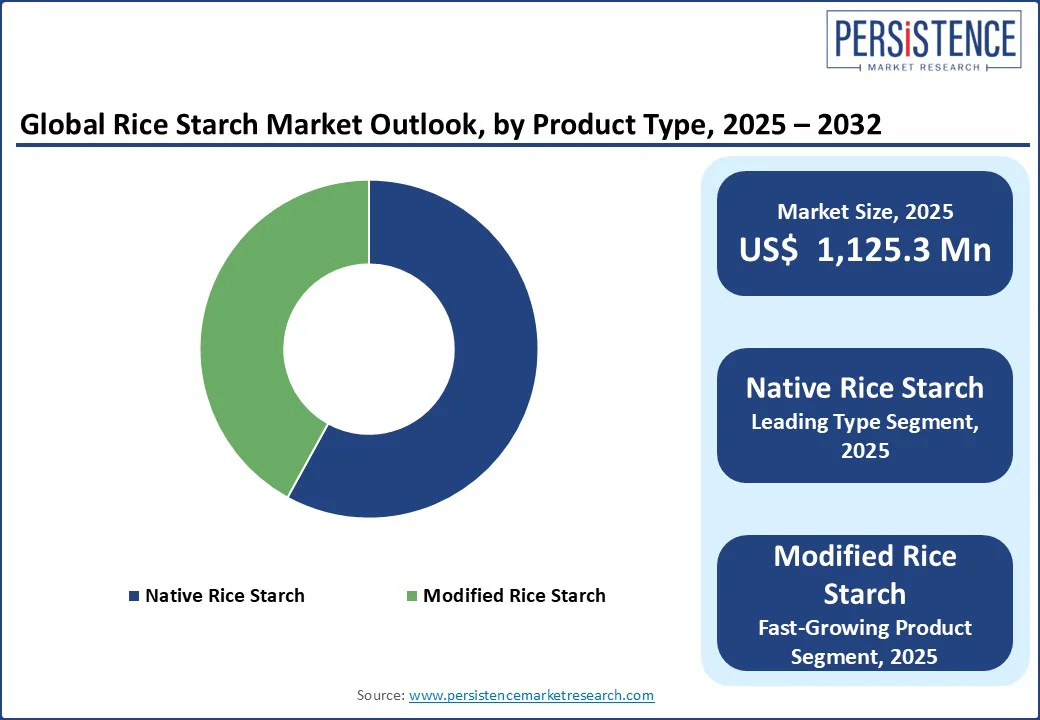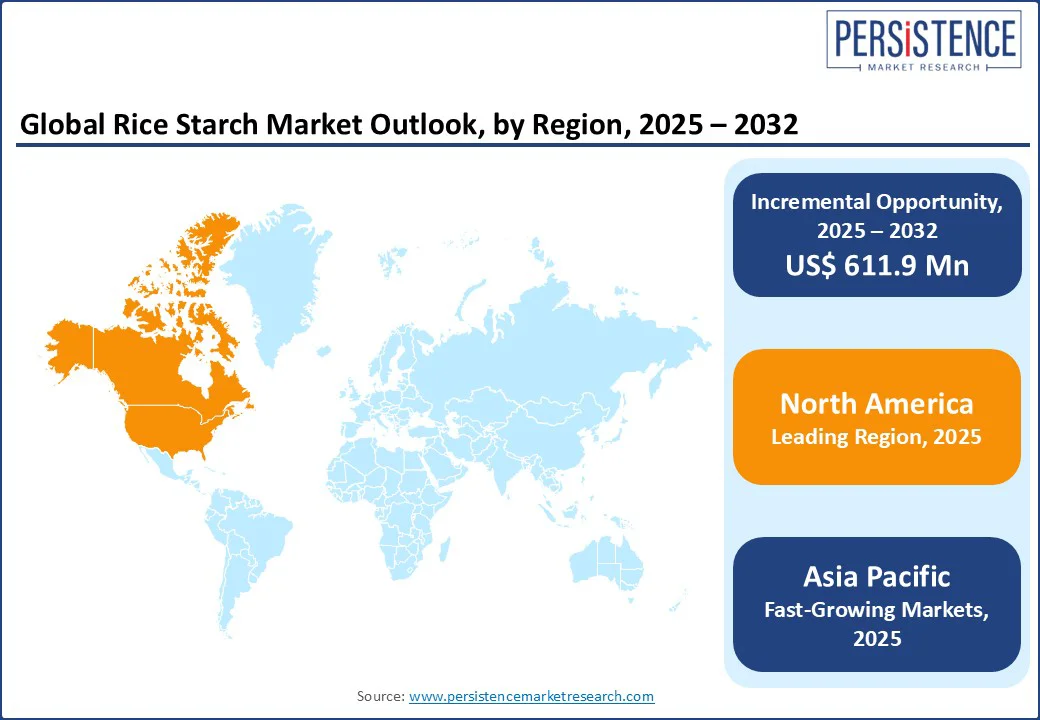ID: PMRREP16144| 186 Pages | 5 Aug 2025 | Format: PDF, Excel, PPT* | Food and Beverages

The global rice starch market is likely to be valued at US$1,125.3 million in 2025 and is expected to reach US$1,737.2 million by 2032, growing at a CAGR of 6.4% during the forecast period from 2025 to 2032. The market growth is driven by rising clean-label preferences, native starch functionality, and expanding non-food applications in cosmetics, pharmaceuticals, and pet nutrition, particularly across North America and Western Europe.

Key Industry Highlights:
|
Global Market Attribute |
Key Insights |
|
Global Rice Starch Market Size (2025E) |
US$ 1,125.3 Mn |
|
Market Value Forecast (2032F) |
US$ 1,737.2 Mn |
|
Projected Growth (CAGR 2025 to 2032) |
6.4% |
|
Historical Market Growth (CAGR 2019 to 2024) |
4.9% |
The rising demand for gluten-free formulations is significantly driving the expansion of the global rice starch market. Rice starch, naturally gluten-free and hypoallergenic, is increasingly preferred as a clean-label alternative in baked goods, sauces, snacks, and baby foods. This trend is bolstered by growing consumer awareness of celiac disease and gluten intolerance, as well as broader lifestyle choices favoring gluten-free diets. According to consumer survey, the number of consumers adhering to a gluten-free diet doubled between 2019 and 2024, despite stable diagnosis rates for celiac disease, reflecting a strong lifestyle-driven preference. Manufacturers are reformulating products using rice starch as a texture enhancer and stabilizer to cater to this expanding demographic. As gluten-free demand transitions from niche to mainstream, rice starch continues to gain momentum across global food, pharmaceutical, and personal care sectors.
Fluctuating paddy prices and weather-related disruptions pose a significant restraint on the global rice starch market by undermining supply chain consistency and cost predictability. Since rice starch is extracted from broken or lower-grade rice, volatility in paddy prices driven by seasonal yields, speculative trading, or export policies directly affects input costs for starch manufacturers. Moreover, unpredictable climate events such as floods, droughts, or unseasonal rainfall can sharply reduce rice harvest volumes, tightening raw material availability and triggering price spikes. This inconsistency complicates long-term procurement planning and margin forecasting for both producers and B2B buyers in the food, pharma, and cosmetic sectors. Additionally, regional sourcing risks, particularly in climate-sensitive zones of Asia, amplify vulnerability to supply shocks, limiting scalability for global contracts and deterring investment in rice starch-based product innovations.
Innovations in food processing technologies are unlocking substantial new opportunities in the global rice starch market. Advances such as ultrasonication, enzymatic modification, and microencapsulation are improving the functional properties of rice starch, such as solubility, thermal stability, and emulsifying capacity. These breakthroughs enable rice starch to replace synthetic additives in a variety of clean-label applications, from shelf-stable sauces to heat-resistant confectionery fillings. Additionally, precise processing allows the creation of highly customized starch grades, meeting the detailed needs of specialized sectors like infant nutrition, plant-based dairy, and gluten-free baking. As consumer and regulatory pressures increase around food safety and transparency, these innovations position rice starch as a high-functionality, allergen-free ingredient. Companies utilizing these technologies are likely to gain early advantages in emerging applications and niche B2B supply chains across the food industry.
Native rice starch holds approximately 58% of the global rice starch market in 2024, driven largely by its strong alignment with the clean-label movement. Consumers are increasingly scrutinizing ingredient lists, favoring recognizable, minimally processed inputs, making native rice starch an ideal thickening and texturizing agent in “free-from” and organic food categories. Its natural origin, allergen-free status, and GMO-free profile make it especially attractive in infant foods, ready meals, and clean-label bakery products. The growing aversion to chemical additives across Western and Asian markets further solidifies its dominance. In contrast, modified rice starch, while offering superior stability under extreme processing conditions, faces stricter labeling requirements and limited appeal in natural-positioned products. However, it continues to find relevance in applications requiring high-temperature tolerance or long shelf life, such as canned soups and frozen meals.
Cosmetics & Personal Care is expected to grow at a positive CAGR in the forecast period, driven by the accelerating demand for clean-label and sustainable ingredients. Consumers are increasingly scrutinizing product labels for transparency, minimalism, and origin of raw materials, prompting manufacturers to shift toward natural alternatives like rice starch. Its hypoallergenic, biodegradable, and non-GMO profile makes it an ideal replacement for synthetic talc, silicones, and microplastics in products such as face powders, dry shampoos, and baby care items. Moreover, rice starch offers functional benefits like oil absorption, mattifying effects, and silky texture, aligning performance with sustainability. As regulatory bodies tighten rules on cosmetic ingredients and plastic waste, brands using renewable, plant-based inputs like rice starch are gaining a competitive edge. This shift marks a deeper transformation toward ethical and eco-conscious product formulation.

The North America rice starch market is experiencing steady growth, driven by clean-label demand, increasing gluten-free consumption, and rising interest in plant-based ingredients. In the U.S., the USDA reports rising rice production in states like Arkansas and California, supporting stable domestic sourcing for rice starch manufacturers. The U.S. food industry is increasingly using rice starch in baby food, baked goods, and processed meats as a functional, allergen-free thickener. Demand is also growing in non-food sectors, especially in biodegradable packaging and pharmaceuticals. In Canada, rice starch adoption is speeding up in organic and specialty food markets due to strict food labeling standards and consumer preference for minimally processed ingredients. The country's reliance on imports, mainly from the U.S. and Asia, further boosts cross-border trade. Both nations are increasing R&D efforts on native and modified rice starch solutions designed for high-performance, clean-label uses.
Europe rice starch market is evolving alongside shifting agricultural policies and changing consumption habits across key markets such as the U.S., Germany, France, Spain, and Italy. EU Commission data shows the bloc produces around 2.8 million tonnes of paddy rice annually, supplying roughly 1.7 million tonnes of milled rice while also importing over one million tonnes to meet food and industrial demand. In Germany and the U.S., rice starch adoption is increasing in clean-label food and pharmaceutical sectors, supported by EU regulations that favor allergen-free alternatives. In southern Europe, particularly Spain and Italy, rice starch use is expanding within gluten-free and convenience food processing, reflecting growing consumer demand for minimally processed ingredients. Throughout the region, a combination of CAP-driven agricultural support and allergen regulation is driving innovation and commercial deployment of rice starch.

The global rice starch market is moderately fragmented, with a mix of established players and emerging innovators competing across diverse applications. Industry leaders are actively expanding production capacities and investing in R&D to develop highly functional rice starch grades tailored for evolving food, cosmetic, and nutraceutical demands. In food applications, innovation is focused on enhancing texture, freeze-thaw stability, and clean-label formulation, especially in baby food, ready meals, and low-allergen products.
In the cosmetics sector, rice starch is gaining momentum as a sustainable, biodegradable thickening and mattifying agent, aligning with growing consumer preference for naturally derived ingredients. Meanwhile, feed manufacturers are exploring native rice starch as a digestible energy source in pet and livestock nutrition. Players are also emphasizing organic, non-GMO, and halal/kosher certifications to strengthen market access and align with global regulatory and ethical consumption trends.
The global rice starch market is projected to be valued at US$1,125.3 Mn in 2025.
Rising demand for gluten-free formulations is driving interest in the rice starch market.
The Global rice starch market is poised to witness a CAGR of 6.4% between 2025 and 2032.
Innovations in food processing technology to create new prospects in the global rice starch market.
Major players in the global rice starch market include Beneo GmbH, Ingredion Incorporated, AGRANA Beteiligungs-AG, A&B Ingredients, Inc., Thai Flour Industry Co., Ltd., Xyprotein, and others.
|
Report Attributes |
Details |
|
Historical Data/Actuals |
2019 - 2024 |
|
Forecast Period |
2025 - 2032 |
|
Market Analysis |
Value: US$ Mn and Volume: Tons |
|
Geographical Coverage |
|
|
Segmental Coverage |
|
|
Competitive Analysis |
|
|
Report Highlights |
|
|
Customization and Pricing |
Available upon request |
By Product type
By Nature
By End-use
By Region
Delivery Timelines
For more information on this report and its delivery timelines please get in touch with our sales team.
About Author